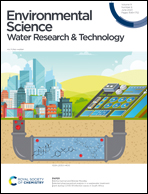Evaluation of membrane fouling in a microalgal-bacterial membrane photobioreactor treating secondary wastewater effluent: effect of photoperiod conditions
Abstract
Microalgal-bacterial membrane photobioreactors (MPBRs) have emerged as a transformative wastewater treatment technology for reducing carbon emissions whilst achieving high quality effluent. However, membrane fouling negatively affects process performance by increasing energy consumption and reducing membrane lifespan. In this study, light/dark photoperiods were varied to optimize treatment performance and biomass properties and reduce membrane fouling. Increasing the length of the light period favored higher production of biomass but decreased bioflocculation. An intermediate photoperiod of 16/8 h achieved high values of biomass concentration (3.21 ± 0.45 g L−1) and nutrient removal rates (4.71 mg N L−1 d−1 and 0.67 mg P L−1 d−1, respectively), while preventing accumulation of biopolymer clusters (≤5.5 mg DOC L−1) in the suspension. In addition, short-term fouling—associated with floc deposition forming a cake layer—was minimized at intermediate photoperiods, thus increasing the sustainable (i.e., threshold) permeate flux. Under these sustainable flux conditions, membrane fouling was mainly determined by the biopolymer cluster content, with best performance being attained at 16/8 h. The above results reveal that the photoperiod is a crucial parameter for controlling membrane fouling in microalgal-bacterial membrane photobioreactors.



 Please wait while we load your content...
Please wait while we load your content...